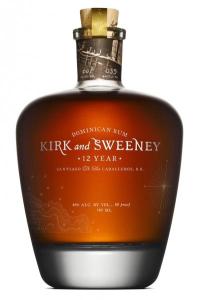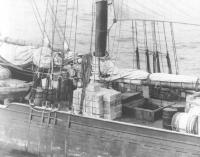 A March snowstorm has descended on the banks of the Hudson River. To be ready for all contingencies, I went out and purchased a decent bottle of rum. One can never be too prepared. I chose a 12 year old Dominican rum, Kirk and Sweeney, named after a Prohibition-era rum-running schooner. That it is named after a schooner wasn’t the only reason that I bought the rum, but it contributed to the decision.
A March snowstorm has descended on the banks of the Hudson River. To be ready for all contingencies, I went out and purchased a decent bottle of rum. One can never be too prepared. I chose a 12 year old Dominican rum, Kirk and Sweeney, named after a Prohibition-era rum-running schooner. That it is named after a schooner wasn’t the only reason that I bought the rum, but it contributed to the decision.
I became intrigued by the schooner behind the rum. According to the distiller, 35 Maple Street, “In 1924, [the Kirk and Sweeney] was seized off the coast of New York with a massive amount of rum aboard.”
The USCG web page — RUM WAR! The Coast Guard & Prohibition tells a similar story :
“Rum-runner sloop KIRK AND SWEENEY with cases and barrels of rum on her deck, was seized by the U.S. Coast Guard about January 13, 1924. A generous supply of cases of liquors were kept on deck to save time when the fast motorboats of comrad[e] smugglers from shore came to make contact outside the three-mile limit (extended to 12-mile limit by Act of Congress April 21, 1924). The KIRK AND SWEENEY was later renamed the CHASE and used as a training vessel at the U.S. Coast Guard Academy in the 1930’s.”
It makes for an interesting story, but having looked into it a bit, I am convinced that both the distiller and the US Coast have the history of the schooner wrong.
In the early years of Prohibition, the owners of Canadian fishing schooners discovered that there was more money to be made selling liquor than in catching fish. They would anchor their schooners, loaded with rum, whiskey and wine, roughly four miles off the coast, just outside the three-mile limits of US waters. There were so many schooners, ships and just about any vessel which could float anchored along the coastline from the Jersey Shore to the end of Long Island, that it came to be called “Rum Row.” Some said that the anchor lights from the vessels on Rum Row looked like a vast floating city.
Because the anchored schooners were outside of US territorial waters, they were breaking no laws and the Coast Guard could do nothing while they remained in international waters. At night, bootlegger’s skiffs and boats would run out to load up on spirits and wine then return home, trying to dodge the Coast Guard, which tried to stop them as they crossed back into US waters.

The deck of the schooner Kirk and Sweeney with cases and barrels of rum on her deck January 13, 1924.
One of the larger rum-running schooners was the Kirk & Sweeney. A photographer for the US Coast took a well-known picture of the schooner’s deck loaded with crates and barrels of booze in January of 1924. They also claimed to have seized the schooner on January 13, 1924.
It is an interesting story but it doesn’t necessarily make sense. If the Kirk and Sweeney was seized on January 13th, what was she doing back out on Rum Row with 16 other vessels anchored off Sandy Hook on March 6th, which is where the New York Evening Post reported her to be.
Overall, it seems highly unlikely that the Coast Guard would seize the schooner in mid-January, that it would be condemned in Admiralty Court, put up for auction, sold to new owners, who kept the original name and then put the schooner back out on Rum Row by early March. There are also no new reports of the schooner being seized. It is possible that the schooner was arrested and released on bond, but it seems very unlikely if a large liquor seizure was involved.
My guess is that the US Coast Guard took the photo of the ship in international waters on January 13th, but didn’t arrest her. The schooner was reported to be in service back in Canada the following year.
But then, how did the Kirk and Sweeney end up as the Coast Guard Cutter Chase?
The Coast Guard history of the Cutter Chase, CG-9277 on their “Cutter History” page tells a somewhat different stort than their “Rum War” version. It reads in part, “The Chase was a captured rum-runner originally built as the Kirk and Sweeney in Yarmouth, Nova Scotia. She was renamed George and Earl sometime after that and was captured by the Coast Guard on 7 December 1934 for violating the Volstead Act.”
So this version has the schooner being arrested eleven years later, after having been renamed George and Earl. One aspect of this story still doesn’t make sense. The Volstead Act was repealed in December, 1933, so if the schooner was arrested in December 1934, it was probably for violating a statute other than the Volstead Act.
The seizure of the George and Earl is interesting in that it was widely covered by the press. This may have been because the arrest was the first major seizure in New York since the repeal of Prohibition. The schooner was also, not arrested offshore, but in New York’s East River. Despite the fact that Prohibition had ended there was still a market for illicit alcohol to avoid the high taxes on imported liquor.
The New York Times headline on December 8, 1934: $330,000 in Alcohol Seized in Harbor
Customs agents of the harbor patrol squad seized 33,450 gallons of high-proof alcohol yesterday in the first big liquor seizure in the port since repeal. They arrested 13 men and seized the rum boat, the fishing schooner George and Earl, with a crew of Canadians, and the tug, Edith Bard, which was attempting to tow the laden craft through the turbulent waters of the turbulent waters of Hell Gate in the East River when the squad sighted them.
The 190-proof alcohol is worth about $330,000 in the domestic market, and the George and Earl, when last appraised in 1927, was worth $20,000.
The Coast Guard took possession of the schooner, which was renamed Chase and used as a training vessel at New London, Connecticut until 1939 after being damaged in the 1938 hurricane. She was then sold to be used in the lumber trade on the Chesapeake Bay without her sailing rig. She later served as a breakwater in the 1950s at Rock Hall, Maryland.
The Kirk and Sweeney had an impressive pedigree before becoming a rum-rummer. She was part of the Laurence Sweeney Fisheries fleet which was one of the largest on the east coast, numbering 80 vessels over the years. It is likely that the schooner Kirk and Sweeney was built in her namesake, Kirk and Sweeney Shipyard in Nova Scotia. Today, the W. Laurence Sweeney Fisheries Museum of Yarmouth, Nova Scotia celebrates the story of the men and women of Laurence Sweeney Fisheries Limited.

Rick,
I read with interest your recent (Dec) post about the Arizona and Oklahoma collision just prior to Pearl Harbor. If Arizona took on a a10 degree list due to the collision and was drydocked for temporary repairs prior to returning to the States for full repairs, might this not have significantly compromised her water tight integrity and stability during the bombing?
Interesting question. Could be.
Pingback: New York History Around The Web This Week | The New York History Blog